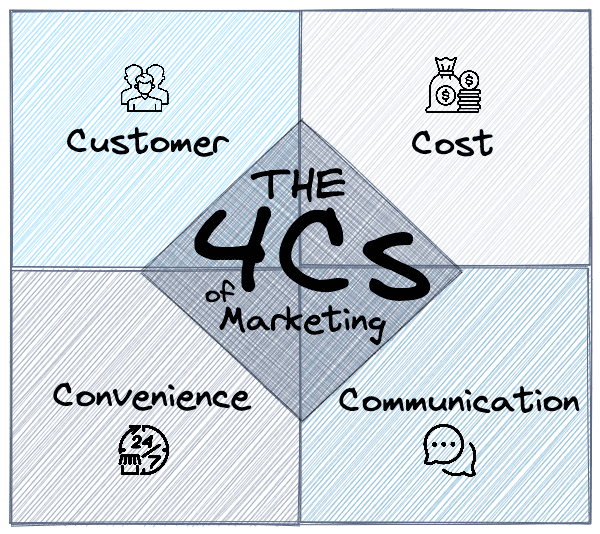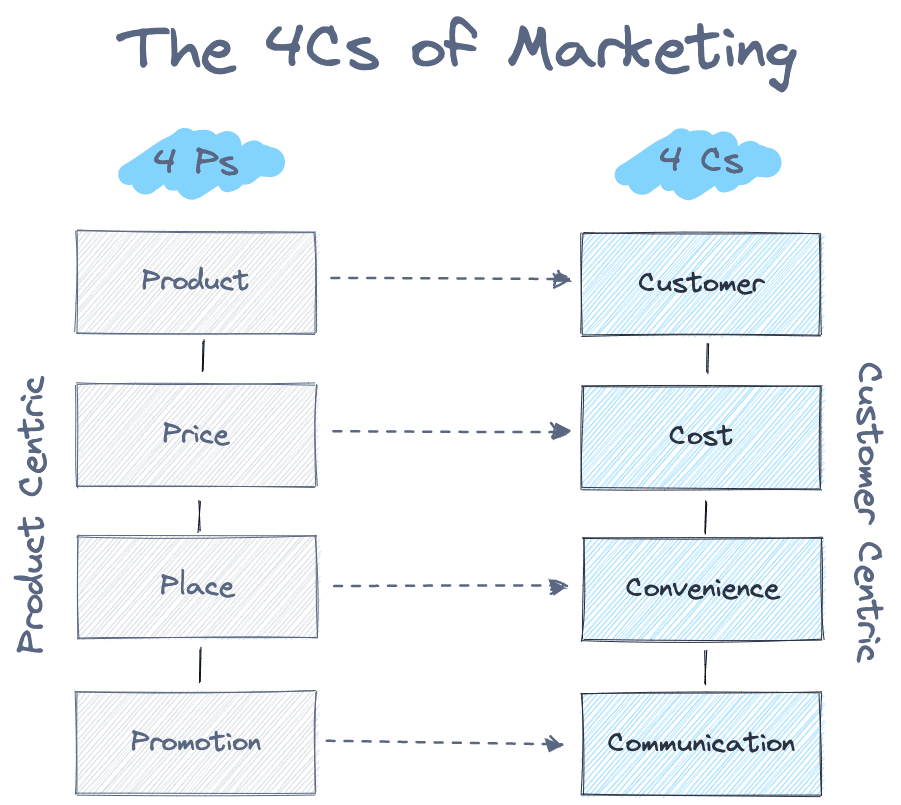As an Entrepreneur, you'll probably be familiarising yourself with digital marketing strategies to develop and promote your products or services.
A few marketing models can be followed. Commonly, the 4 ps of marketing (Product, Price, Promotion, Place) have been key to forming the bases for developing any good business marketing strategy and creating a new product and service.
However, in 1990 an article in Advertising Age written by Bob Lauterborn suggested that the 4 ps were causing products to be created that the customer didn't actually want, and instead, we should focus on the four Cs (Customer, Cost, Communication, and Convenience).

Although traditional marketing methods like the 4ps or 7 ps are still highly effective, Lauterborn noted this isn't a one-size-fits-all world, so customer needs and how we communicate to potential customers must be considered.
Now, the more modern approach for a marketer is to use the 4 c's of marketing, which focus on four key areas to help you better understand your customer and build stronger relationships with them.
Read on to discover why this new framework is everything you should consider as an entrepreneur.
What is the Difference Between the 4Ps and 4Cs of the Marketing Mix?
The main difference between the 4 p's and the 4c's is that the 4ps of marketing are focusing on the product or service itself. This seller-oriented marketing is more focused on selling products and how you get those products to the customer instead of focusing on what the customer needs and wants.
The 4c's approach to marketing is a lot more customer-centric. It draws focus to what the customer wants and needs, allowing you to create much more valuable marketing campaigns as you understand what your ideal customers like and want.
By using the 4c's you can conduct market research to understand the needs of customers, therefore improving communication between buyer and seller. As an entrepreneur, you can use this method to ensure you're providing value and, therefore, reduce friction in the purchasing process.

How to use the 4 Cs of marketing
1. Customer wants and needs (Instead of Product)
To start off, you need to consider your customers' wants or needs. Previously, you may have focused on the product itself, whereas here, we want to understand what need we are helping to satisfy for our target audience. What problems do we solve? What are the transformations we deliver in our service?
As an entrepreneur, it's really important to understand your customer's desires. What motivates and drives them, and what can you provide for them which will help in filling a void? When a service or product is created before you truly understand this, you're at risk of trying to sell something which isn't enough for the customer or that doesn't serve a definite purpose.
First, understand your ideal client's wants, needs, and desires so you can ensure you can add true value to those you are hoping to serve.
Colin Scotland
2. Cost (Instead of Price)
It's important you don't confuse cost with price. The price of what you're selling is just a small factor in the overall cost of the product or service.
The total cost of your product or the service you provide takes into account what it takes for the customer to purchase your product. This can include the time it takes for the customer to get to you if you offer an in-person service. In a world where we shop online, it may include delivery costs and the time it takes to get the product to them.
From an entrepreneur's perspective, this is where you need to show the value and benefits of what you're selling. So the total cost of the product or provided service becomes a no-brainer when you stack it against the amount of value and the transformation it brings.
3. Convenience (Instead of Place)
The third C we need to consider is convenience. Formerly 'Place' would determine where we would sell our wears, but now we really need to understand how and where our customers will purchase products. Whether they prefer to talk to someone first or would rather be able to use a simple checkout process (check out my article on ThriveCart for online check-out!).
In a world where we want quick, convenient, and fast results, your overall goal is to make the customer journey as simple as possible.
4. Communication (Instead of Promotion)
The fourth and final C stands for communication. Whether you are a small business, corporate giant, or entrepreneur, how you communicate with your audience is what's going to make or break your business.
How we communicate has greatly developed over the years, with platforms such as social media becoming key channels in how we communicate both personally and professionally. Historically, promotion could have been considered a manipulative (for want of a better word) form of generating sales. Nowadays, trust is a much stronger factor in the buying process.
Communication requires interaction and engagement between both parties. It's also expected for businesses to respond in a timely manner. Communication must build trust and mutually beneficial relationships. There also needs to be a level of customer support if you are to gain and retain customers over time.
Implementing the 4Cs of marketing
It's no longer a case of simply promoting what you're selling. You need to cater to the needs of your customers and build a meaningful relationship with them.
By following the 4Cs process, you'll gain a deeper understanding of your target audience and how best to serve them. This will allow you to tailor what you're creating to suit them rather than assuming you know what they want.
If you combine having something they need or want with convenience and communication that really connects with them, it is a powerful way to generate more sales.





